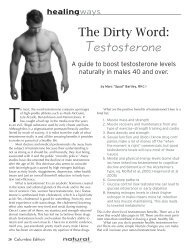February 2013: Bodywork and Relationships - Columbia Natural ...
February 2013: Bodywork and Relationships - Columbia Natural ...
February 2013: Bodywork and Relationships - Columbia Natural ...
You also want an ePaper? Increase the reach of your titles
YUMPU automatically turns print PDFs into web optimized ePapers that Google loves.
greenliving<br />
Rest in Peace<br />
Sustainable Burials Honor Life<br />
Humans are conditioned to the<br />
conventional rituals of h<strong>and</strong>ling<br />
death—the embalmed<br />
body in a casket or ashes sealed in an<br />
urn, a procession of vehicles to the<br />
burial site, solemnly gathering <strong>and</strong><br />
scattering flowers as the remains are<br />
lowered into the earth. Many times,<br />
planning details are abdicated to the<br />
judgment of funeral directors.<br />
The notion of green burials envisions<br />
something different: a ceremony<br />
that engages family members’ eco-values<br />
<strong>and</strong> nature in a more intimate, sustainable<br />
process favoring biodegradable<br />
caskets <strong>and</strong> no toxic chemicals.<br />
The movement is gaining in popularity;<br />
in 2011, some 300 US funeral homes<br />
offered green burial options, up from<br />
only 12 in 2008.<br />
High Impact of Tradition<br />
Traditional American burial practices<br />
make a sizeable environmental footprint<br />
<strong>and</strong> also pose health risks. The<br />
carcinogenic embalming fluid—formaldehyde—is<br />
a well-known hazard. A<br />
by Brita Belli<br />
2009 study in the Journal of the National<br />
Cancer Institute found that exposure<br />
to formaldehyde over a career of<br />
embalming put funeral home workers<br />
at significantly increased risk for mortality<br />
from myeloid leukemia, a cancer<br />
of the blood cells. Alternatives include<br />
formaldehyde-free preservatives made<br />
from essential oils, <strong>and</strong> dry ice.<br />
Significant resources are consumed<br />
in manufacturing caskets <strong>and</strong> vaults<br />
<strong>and</strong> maintaining cemetery grass. “A few<br />
years back I calculated that we bury<br />
enough metal in caskets to rebuild the<br />
Golden Gate Bridge each year <strong>and</strong> put<br />
so much concrete in the ground via<br />
burial vaults we could build a two-lane<br />
highway halfway across the country,”<br />
says Joe Sehee, founder of the Green<br />
Burial Council.<br />
The council certifies <strong>and</strong> lists<br />
cemeteries, funeral homes <strong>and</strong> casket<br />
companies that forgo chemicals <strong>and</strong><br />
offer natural l<strong>and</strong>scapes. The goal is for<br />
burials to leave as little impact as possible<br />
on the planet.<br />
Greener Plots<br />
Greensprings <strong>Natural</strong> Cemetery Preserve,<br />
in Newfield, NY, does not look<br />
like a cemetery. Its native grasses <strong>and</strong><br />
mature trees come alive with color<br />
each autumn. Wildflowers bloom in<br />
the spring <strong>and</strong> birds build their nests in<br />
treetop boughs.<br />
“Most contemporary cemeteries<br />
are biological deserts,” observes<br />
Greensprings spokesperson <strong>and</strong><br />
science writer Mary Woodsen. In contrast,<br />
Greensprings’ 100 acres are surrounded<br />
by 8,000 acres of protected<br />
forests. Loved ones may be buried in<br />
coffins from locally produced timber,<br />
or in shrouds—either professionally<br />
made or from a favorite blanket or<br />
quilt. Biodegradable caskets may<br />
be constructed of pine, cardboard,<br />
bamboo, formaldehyde-free plywood<br />
or h<strong>and</strong>-woven willow or wicker.<br />
LastThings.net even offers free plans<br />
to make a simple coffin.<br />
Instead of a machine, family<br />
members <strong>and</strong> friends ceremonially<br />
take hold of straps <strong>and</strong> lower the casket<br />
into a concrete vault themselves.<br />
<strong>Natural</strong>, flat fieldstones honor loved<br />
ones.<br />
“People feel, ‘I was part of this,’”<br />
says Woodsen.<br />
Cremation Options<br />
Debate exists over the ecological<br />
impact of cremation—a practice expected<br />
to be chosen as the end-of-life<br />
choice for as many as 46 percent of<br />
Americans by 2015. While it reduces<br />
the use of large, resource-intensive<br />
burial plots, each traditionally cremated<br />
body releases 110 pounds of<br />
greenhouse gases <strong>and</strong> other pollutants,<br />
including carbon dioxide <strong>and</strong><br />
monoxide, nitrogen oxides, sulfur<br />
dioxide, mercury <strong>and</strong> other metals.<br />
The Bio Cremation greener alternative—using<br />
95 percent water <strong>and</strong> 5<br />
percent of an alkali instead of flames<br />
<strong>and</strong> fossil fuels—requires eight times<br />
less energy as fire-based cremation,<br />
produces no dangerous byproducts<br />
<strong>and</strong> still yields ashes from the remaining<br />
bones. To find the states that have<br />
approved the process, visit the legislative<br />
section at BioCremationInfo.com.<br />
Biodegradable urns are also available,<br />
including cornstarch bags ac-<br />
HealthyLiving<strong>Columbia</strong>.com<br />
<strong>February</strong> <strong>2013</strong><br />
25







